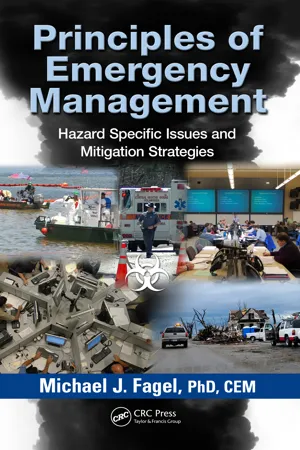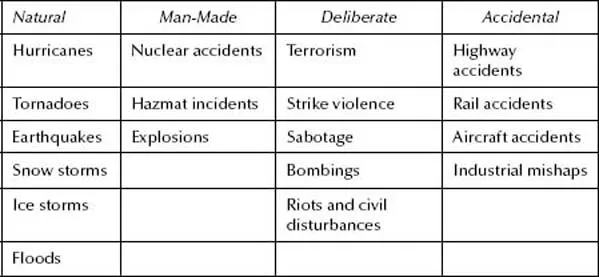
eBook - ePub
Principles of Emergency Management
Hazard Specific Issues and Mitigation Strategies
- 585 pages
- English
- ePUB (mobile friendly)
- Available on iOS & Android
eBook - ePub
About this book
Principles of Emergency Management: Hazard Specific Issues and Mitigation offers preparedness and mitigation recommendations for advanced emergency planning. Because disasters are so unpredictable, advance planning is needed to effectively respond to and mitigate against the potential effects of such events.Whether a disaster is natural or man-made
Frequently asked questions
Yes, you can cancel anytime from the Subscription tab in your account settings on the Perlego website. Your subscription will stay active until the end of your current billing period. Learn how to cancel your subscription.
No, books cannot be downloaded as external files, such as PDFs, for use outside of Perlego. However, you can download books within the Perlego app for offline reading on mobile or tablet. Learn more here.
Perlego offers two plans: Essential and Complete
- Essential is ideal for learners and professionals who enjoy exploring a wide range of subjects. Access the Essential Library with 800,000+ trusted titles and best-sellers across business, personal growth, and the humanities. Includes unlimited reading time and Standard Read Aloud voice.
- Complete: Perfect for advanced learners and researchers needing full, unrestricted access. Unlock 1.4M+ books across hundreds of subjects, including academic and specialized titles. The Complete Plan also includes advanced features like Premium Read Aloud and Research Assistant.
We are an online textbook subscription service, where you can get access to an entire online library for less than the price of a single book per month. With over 1 million books across 1000+ topics, we’ve got you covered! Learn more here.
Look out for the read-aloud symbol on your next book to see if you can listen to it. The read-aloud tool reads text aloud for you, highlighting the text as it is being read. You can pause it, speed it up and slow it down. Learn more here.
Yes! You can use the Perlego app on both iOS or Android devices to read anytime, anywhere — even offline. Perfect for commutes or when you’re on the go.
Please note we cannot support devices running on iOS 13 and Android 7 or earlier. Learn more about using the app.
Please note we cannot support devices running on iOS 13 and Android 7 or earlier. Learn more about using the app.
Yes, you can access Principles of Emergency Management by Michael J. Fagel in PDF and/or ePUB format, as well as other popular books in Law & Global Development Studies. We have over one million books available in our catalogue for you to explore.
Information
Chapter 1
Introduction: Why Plan for Disasters?
Contents
Types of Disasters
Phases of Disaster
Levels of Severity
Why Plans Fail
Planning as a Blueprint
The Disaster Cycle and Planning.
Mitigation
Preparedness
Response
Recovery.
A Brief History of Emergency Management
Authorities and Directives
Robert T. Stafford Act
Homeland Security Act of 2002
Post-Katrina Emergency Management Reform Act
Presidential Decision Directives
Homeland Security Presidential Directives
HSPD-, Management of Domestic Incidents
HSPD-, National Preparedness.
Other Policy References
Response Plans
Emergency Support Functions
ESF Support Agencies
Federal Response Plan
National Response Plan
National Response Framework
Emergency Support Functions
ESF Support Agencies
Conclusion
Disasters happen. No one is immune to them or the devastation that they can bring to communities of any size. Disaster applies to a variety of events, each with varying magnitudes and of varying natures. The Federal Emergency Management Agency (FEMA) defines a disaster as
an occurrence of a severity and magnitude that normally results in deaths, injuries, and property damage and that cannot be managed through the routine procedures and resources of government
Because of the unpredictable nature of disasters, it is essential to plan for such events. Only through planning is it possible to effectively respond to and mitigate against the potential effects of disaster.
Types of Disasters
Disasters usually fall into one of four categories: natural, man-made, deliberate, or accidental. In the United States, the most frequently occurring disasters are natural. Because natural disasters are not caused by the actions of humans, they are the most difficult to prevent. However, because most, although not all, natural disasters (e.g., weather related) are predictable, they should be the easiest to plan for.
Because it is impossible to stop natural disasters from occurring, emergency planners and responders must increase their awareness of how and why they occur. At the same time, they must analyze the risk in their communities so that they can focus their efforts on the highest risk or highest impact hazards. For example, Florida residents need not prepare for paralyzing blizzards. They must be prepared for hurricanes, however. On the other hand, New England residents need to be prepared for both blizzards and hurricanes as well as a multitude of other hazards.
Man-made disasters fall into two categories: deliberate and accidental. To identify a single cause of any man-made disaster would be nearly impossible. For as many types of man-made disasters that exist, there are a hundred reasons why. Whereas natural disasters are caused by the forces of nature and can only be predicted, not prevented, man-made disasters occur through preventable, sometimes deliberate, and often malicious acts.
Not all man-made disasters are deliberate, however. Many can be categorized as accidental and completely unexpected. As we continue to enter the era of technology, an increasing number of technologically sophisticated incidents will continue to occur, and community disaster plans must take into account the potential for an increasing number of incidents involving toxic spills, radiological releases, and other accidents. The events could be highly disastrous in densely populated areas, and as communities continue to grow, these events could have consequences that expand beyond the realm of anything imaginable in today’s society.
Table 1.1 represents the types of disasters that fall into the categories just presented. This list is not intended to be inclusive, and certainly there are other potential disasters that could strike any community. For this reason, when the time comes to create or revise the community’s disaster plan, it is critical that planners be prepared to protect their communities from these and other potential disasters that may occur at any time, with or without warning.
Each of these situations poses its own threat to communities and challenges to emergency response personnel. Some are relatively easy to predict, whereas others may occur with virtually no warning. Some will devastate a community for weeks or months, whereas others may pack a powerful punch, then be over, leaving devastation in their wakes.
It can be expected that most disasters, regardless of type or cause, will bring about some degree of death, injury, and property damage. Depending on the circumstances, disruption in communications systems, power, and water supplies; contamination of air, food, and water; and a multitude of other problems may also occur.
Table 1.1 Types of Disasters

Phases of Disaster
Each type of disaster and its subsequent response effort—regardless of how, when, or why it takes place—can be expected to consist of a number of phases that are fairly consistent. The success of a community’s response plan depends greatly on the planner’s understanding of these phases and how they are incorporated into the overall disaster plan.
The initial phase of a disaster is the warning phase. It is during this phase that emergency officials have the best opportunity to provide the public with disaster-related information. It is also during this phase that an evacuation or shelter in place, if necessary, will be initiated.
The second phase of a disaster is the threat and impact phase. This phase is typically followed by the inventory, rescue, remedy, and restoration phases.
Levels of Severity
Within each type of disaster, varying levels of severity will exist, each with its own response requirements. There are three levels of disaster, and even the lowest level can require the involvement of state and federal officials.
Level I Disaster—A localized multiple-casualty incident wherein local medical resources are available and adequate to provide for field medical treatment and stabilization, including triage. The patients will be transported to the appropriate medical facility for further diagnosis and treatment.
Level II Disaster—A multiple-casualty emergency where the large number of casualties and/or lack of medical care facilities are such as to require multijurisdictional medical mutual aid.
Level III Disaster—A mass-casualty emergency wherein lo...
Table of contents
- Cover
- Title Page
- Copyright Page
- Table of Contents
- Dedication
- Foreword
- Preface
- Acknowledgments
- Editor
- Contributors
- 1: Introduction: Why Plan for Disasters?
- 2: EOC Management and Operations
- 3: Continuity of Operations Planning
- 4: Strategizing Emergency Management Programs
- 5: The Hazards among Us
- 6: The Role of the Public Health Official
- 7: Developing Public–Private Partnerships in the Twenty-First Century
- 8: Assessing Vulnerabilities
- 9: The Common-Sense Guide for the CEO
- 10: Planning and Exercise
- 11: Planning for Terrorism
- 12: EOC Management during Terrorist Incidents
- 13: The Active Shooter Incident
- 14: Terrorist Tradecraft I: The Attack Cycle
- 15: Terrorist Tradecraft II: Case Studies—Past, Present, and Future
- 16: Agroterrorism
- 17: Pandemic Preparedness
- 18: Special Events
- 19: Mass Care, Sheltering, and Human Services
- 20: Children and Disasters
- 21: Emergency Management and the Media
- 22: Impact of Social Media on Emergency Management
- Afterword
- Index